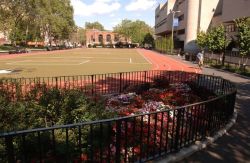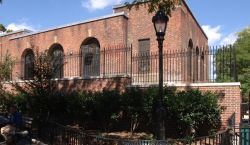Sara D. Roosevelt Park
Houston Street Playground
Houston Street honors the American patriot, William Houstoun (1755-1813). Born in Savannah, Georgia, he was the son of Sir Patrick Houstoun, a Scottish member of Georgia’s royal colonial government. Houstoun received a liberal education that included legal training at Inner Temple in London. When the Revolutionary War erupted in 1775, he returned from London to his predominantly royalist family in Georgia. Against his father’s will, Houstoun staunchly supported the colonists’ grievances, and later championed armed resistance.
Following the colonial victory in 1783, Houstoun served as a Georgia delegate to the Continental Congress from 1783 to 1786. In 1785, Houstoun settled Georgia’s border dispute with South Carolina. He also attended the Constitutional Convention, during 1787, for approximately two months. In 1788, William Houstoun married Mary Bayard. Following his death, William Houstoun was interred at St. Paul’s Chapel in New York City. In the 1790s, Mary’s father, Nicholas Bayard III, constructed a street that ran east to west through a tract of land he owned, and named the thoroughfare after his son-in-law, William Houstoun.
In 1833, Houstoun Street was extended to connect with North Street, which at the time was the city’s northernmost border on the East Side. That year, Houstoun Street replaced North Street as the thoroughfare’s official name. The current spelling of the street, Houston, is actually a corruption; the last correct spelling of the street’s name was recorded in 1811. Because of this mistake, the name is often incorrectly cited as a reference to Sam Houston (1793-1863), the commander of the Texas Army during the Texas War for Independence.
The parkland was acquired by the City in 1929 for the purpose of widening Chrystie and Forsyth Streets and building low-cost housing, but was later set aside for “playgrounds and resting places for mothers and children.” The construction of the park in 1934 was the largest park project on the Lower East Side since the acquisition of Tompkins Square Park a century earlier. Parts of four streets were closed (Hester, Broome, Rivington, and Stanton) to accommodate seven distinct play areas with separate playgrounds for boys and girls, as well as two wading pools, a roller skating rink and a perimeter of benches and shade trees.
Check out your park's Vital Signs
Clean & Safe
Green & Resilient
Empowered & Engaged Users
Share your feedback or learn more about how this park is part of a
Vital Park System










